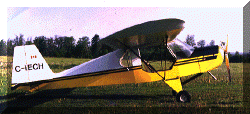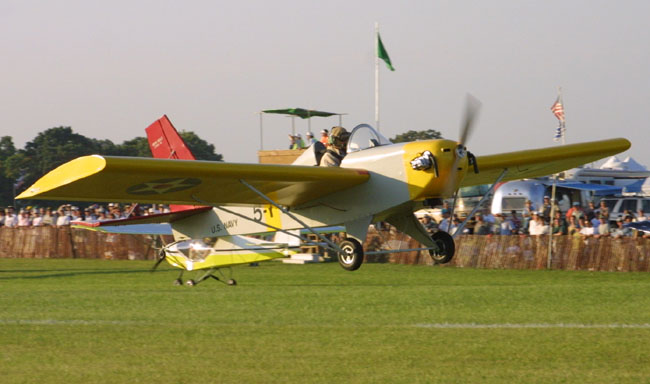|
Also, consideration must be given to speed and
range. Once you have decided what kind of a craft will fit the bill, the most important
consideration is convincing the wife on how much money you can spend!
If you use this article correctly, it will prevent a great deal
of headaches down the road and should save you money when purchasing your craft. The least
it will do is prevent you from becoming a "test pilot".
The following is a
simple ten point program that can be used for either new or used aircraft. In my mind a
passing score is 70% or over, to completely fail would be 50% or under.
1.The number of years the factory has been building planes:
The
longer the better, 5 years gets you 10 points anything less is 2 points less for each
year.
Why must the manufacturer be in business for at least 5 years?
Here is an example. In 1984 a new factory shows up with a brand new aircraft at a show.
The craft on display is the original prototype with about 20 hours of flight time on it.
The plane is well received and nearly 30 orders are taken. The show is in April, first
deliveries are about 4 months later. The craft in question takes about 250 hours to build for first time builders. The normal
builder can spend about 5 hours a week on average building his plane. 5 into 250 is 50
weeks, meaning his craft is ready to fly approximately 1 year after receipt of kit, which
was 4 months after placing his order. The kit is ready to fly in August of 1985. Now the
pilot begins to fly his craft. Like anything new some problems are encountered. The
average pilot flies about 50 hours a year, and lets say his problems start at this time.
The year is now 1986. These problems are reported to the factory. The factory looks at the
problems and begins changing the design of the aircraft. In most cases they already have
material designed for the older style of craft, which they use to prepare any remaining
kit orders.
The pilot checks to see what other updates the factory has put out. To his amazement there
are 22 updates to his craft. After pricing the updates he calculates the cost at about
$2,800. His craft is worth about $4,000 on the open market, and a new plane sells for
$6,200 in kit form rather than update he decides he is better to sell and buy a new kit.
Who is he going to sell his aircraft to....... My recommendation is if you are buying used
buy an aircraft that has been in production for at least 3 years. example: If the first
kit produced was in 1985- buy a 1988 or later model.
2 points off for every year less than 5 that the manufacturer has been in business.
2. The number of planes that have been sold, and the
number of planes that are actually out there flying: flying:
It
is fine to sell 1,000 aircraft kits, but if it takes 500/1,000 hours to build a kit then
it will be some time before those kits are actually flying and problems associated with
their use are reported back to the factory, for correction.
Most of the factories that I have had dealings with over the years are selling at least 10
kits a month. This means that if they have been in business for 5 years they have produced
a minimum of 5 x 12 x 10 = 600 aircraft. 600 aircraft flying generally means that even if
the manufacturer goes out of business it is would be economically feasible for other
manufacturers to produce parts and pieces (sails/tubing/brackets) for this
aircraft.
10 points for 100 kits sold.
If the manufacturer has not sold 100 kits delete 2 points for every 10 below 100.
Many quick build kits such as the Quicksilver MX are ideal aircraft for this kind of
chart. The kit takes about 50 hours to build, sometimes in a little as a week the owners
had their craft flying. Because of this they would be flying very quickly resulting in
problems being reported to the factory. With the marketing used by Eipper it was reported
that in a 4 year span some 10-12,000 kits were delivered world wide. 3. 10 points for 100 aircraft flying. Delete 2 points for every 10 below 100.
4. Control system :
- 3 axis standard control gets you 10 points
- weight shift in a trike gets you 10 points
- 2 axis control gets you 5 points*
-
weight shift control other than trike gets 2 points
Standard three axis control systems get 10 points as do trikes because they allow flight
in more varied conditions, during more hours of the
day. They also give the pilot cross country capability because he knows that he can land
in a cross wind at another field.
Two axis control only receives 5 points due to the crafts limitation in cross wind, and
windy conditions. Most two axis control aircraft will be flown in early morning or late
evening conditions, and usually just around the take off and landing site.
*I give this type of craft 10 points if the owner is buying the craft to fly in these
conditions. I know of many pilots who own two axis control aircraft on floats, who fly
only morning/evenings or on weekends from the lake where their cottages are located.
5. Engine: Rotax engine gets you 10 points. Any
engine that is still in production gets you 8 points, Cuyuna, Kawasaki 6 points.
I give Rotax a 10 because they have engines from 28 to 79 horsepower which can be bought as a complete package, including
carb, exhaust, and cooling systems. Have a worldwide service network, which is factory
trained. Rotax itself is not a small company and produces nearly 80 per cent of the
engines used in light recreational aircraft.
Hirth engines fall short in some of the areas
mentioned above but still should receive an (8). Cuyuna was one of the mainstays in the
industry, parts are available. The only problem with the Cuyuna was that it was either a good reliable
engine, or it made a great boat anchor. (8)
Kawasaki was another engine that was widely used. Unfortunately it is harder to get parts
and pieces for it, and it generally wasn't sold as a complete package meaning that the
exhaust and carbs in many cases were not matched to the engine.(8)
6. Two place trainer: If the company
produces a two place trainer then the plane gets a 10. It is great to be able to buy a
plane when you can be trained in the same model in a two place.
While some of the climb
rates and speeds may be different between he single and two place, the basic flying of the
two craft is very similar. Having flown/and taught students to fly in the Challenger,
Kolb, Buccaneer, Rans Coyote, Airaile, Quicksilver MX and MXL, Carrera in both the single
and two place versions I can vouch for the fact that these craft fly very similar.
If the company does not produce a two place trainer, but your local dealer, or instructor
has flown the craft and indicates that its flight characteristics are similar to the craft
you are training in give it a 10.
If no information on the flight characteristics are readily available, from a
knowledgeable source, then I would first grade the aircraft minus this category (90 points
instead of 100), and then if it passes the other categories give it the per centage that
it passed by e.g. 60 % = 6 points, and then recalculate.
7. Cross country capabilities:
If the plane has good cross country capabilities 50 to 55 mph cruise then you get another
10 points. Once again if the craft has been purchased for the sole purpose of flying
"around the patch" at 25 to 35 mph you can still give it a 10. However if it is
three axis control and capable of 50 to 55 mph in cruise it means that more use can be
made of the craft flying to flyins and other pilots fields. It also is less bothersome to
neighbors, since you are not buzzing away in their ears for extended periods of time.
2 Points off for ever 5 MPH cruise below 55. 8.
Dealer: If there is dealer within 100 miles give the
plane a 10. Many factories sell direct. Unfortunately this means that you have no dealer
support, for training, or parts and pieces. In some cases it means that you might not have
a place close by to fly from with other pilots. Many dealers have engine specialist on
staff with many hours of trouble shooting experience. Also a dealer can teach you how to
fly. These problems are generally not part of the factory support package.
2 points off for every 10 miles from dealer.
If you have to buy direct from the factory, but a dealer near you stocks parts and pieces
and offers training 8 points
9. Planes in the area: If
there are a lot of that plane flying in the area, or you can talk to more than 5 owners
who fly a lot then give it a 10. 2 points off for each pilot less than 5. I have never
heard a mother say that her child is ugly! You are not very likely to hear a factory or a
dealer tell you about the problems with their aircraft. The more people you can talk to
the more feedback, both positive and negative you will receive. Better to make you own
judgment.
10. Safety Record: What is
the planes overall safety record in the years it has been produced? If the type of craft
you are considering has no unexplained accidents give it a 10. If there seem to be several
accidents with no apparent cause I would be a little nervous.
DO NOT, I repeat DO NOT get
this information by word of mouth from a dealer. Get the facts from pilots, publications
or government agencies.
If I were just entering the ultralight market the area of this chart that I would be most
concerned about is number
8. The local dealer, and his customers. If there is a dealer
near you, who has been able to survive the roller coaster ride that this industry has gone
through, then he/his customers should be able to supply to with information on the
industry and the craft you are considering. He can also supply you with parts, service,
and a flying site. In my mind a craft without a dealer is like a one parent family. A
mother and father (manufacturer & dealer) can supply a child (aircraft) the necessary
care and attention that one may not be able to provide.
This is part one in a two part
series. The second part will be dealing with used ultralights and things that you should
look at on the aircraft, prior to buying. Basically it is a used aircraft buyers guide and
will deal with many of the major brands of used aircraft, including those that are no
longer in production. It will also list problem areas, parts suppliers, and give an
approximate value of an aircraft in Good condition/Fair condition/and the area in between.
Using part one and two together should ensure that you get the safest most cost efficient
craft for your buck.
U.B. Judge
|


 flying:
flying: 
